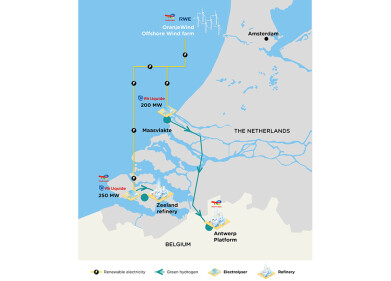Green energy
AC Plasma for distributed turquoise hydrogen production without CO2 emissions
Jun 29 2021
Author credit – Stephen B. Harrison, Managing Director, sbh4 consulting
It is hard to imagine what could derail the development of the emerging hydrogen economy. Positive sentiment and momentum related to the use of hydrogen as a renewable energy vector are at an all-time high. Many industrial, energy and transport applications will pull for significantly more hydrogen to displace fossil fuels.
The conviction to use hydrogen will stimulate major national infrastructure investments such as hydrogen distribution pipelines. Regional liquid hydrogen storage and distribution networks will also emerge. However, in no country does the hydrogen transmission and storage infrastructure yet exist. Until the hydrogen transmission infrastructure is mature, localised hydrogen production and utilisation can jump-start the hydrogen economy.
In a timely development, Plenesys (a start-up based close to Nice in south-eastern France) is developing a small scale, low-capex onsite hydrogen generator. It is a ‘plug and play’ solution for small to mid-scale on-site hydrogen supply and would suit, for example, fuelling stations to enable them to add hydrogen to their fuels offering.
The technology they use is AC plasma methane pyrolysis to produce so-called ‘turquoise’ hydrogen. Their basic unit is designed to produce 100 tonnes per year of hydrogen at a consumption of about 150kW of electrical power. A larger unit with a plasma torch of about 1.5MW, producing 1000 tonnes per year of hydrogen, is also in development.
The only inputs this process requires are water, methane (from piped natural gas or biomethane), and electrical power. These feedstocks and utilities are widely available enabling rapid deployment of the technology. The Plenesys equipment enables hydrogen to be generated in the places where it is needed, even before the hydrogen transmission and distribution infrastructure exists.
Beyond mobility applications, there is an established market for small to mid-scale hydrogen supplies in many sectors, such as float glass manufacture, semiconductors, vegetable oil hydrogenation to produce margarine, hydrogenation of middle distillates to produce lubricating oils and biofuels hydrogenation.
At present these industries are supplied with centrally produced hydrogen using costly distribution modes such as high pressure compressed hydrogen or liquid hydrogen. These methods rely on expensive capital equipment and are energy intensive. Onsite decarbonised hydrogen generation is likely to be a cost-effective alternative for many small to mid-scale hydrogen users.
The technology behind the Plenesys process is methane splitting, also known as methane pyrolysis or cracking. Their reactor uses an AC Plasma torch to split the methane into hydrogen and solid carbon, which is formed as a powder, like soot. The process eliminates gaseous CO2 emissions which result from the reforming of natural gas and is the dominant hydrogen production technology today.
In the past 10 years methane pyrolysis to produce turquoise hydrogen has picked up momentum and several companies have piloted various technologies. Ahmed Kacem, COO of Plenesys says that “some plasma-based methane pyrolysis developments have focused on using DC electricity to produce the plasma, but the use of AC power makes the control of the plasma easier, which simplifies the process.”
For instance, AC power eliminates the need for an external magnetic field to stabilise the plasma. The use of AC electricity also minimises the amount of electrical power management equipment required because AC power is readily available from the electricity distribution grid, whereas DC power is not.
“One of the unique aspects of our technology is that we have developed a means of automatically replacing the plasma torch electrodes so that the system can operate continuously”, says Kacem. During pyrolysis, the graphite electrode is gradually consumed, and some turquoise hydrogen processes require periodic shut down to replace the electrodes. The cooling, replacement and re-start can last more than 24 hours in a large plant due to the thermal mass and high temperatures involved. Avoiding this down-time improves equipment utilisation and process economics.
When methane pyrolysis is used to generate turquoise hydrogen, solid carbon is produced as a co-product. In small quantities, that can be compacted and used as a fuel for foundries or as a coke substitute in other processes. Ultimately, when solid carbon is used in these applications, CO2 may be emitted, but the avoidance of the conversion of coal to coke can reduce Particulate Matter, SO2 and NOx emissions significantly and result in wider environmental and health benefits.
To ensure carbon neutrality, turquoise hydrogen can be produced from renewable biomethane and renewable electrical power. It can therefore play a key role in the transition towards green energy.
Events
May 11 2025 Vienna, Austria
May 18 2025 Algiers, Algeria
23rd International Water Management Exhibition
May 20 2025 Prague, Czech Republic
Singapore International Water Week Spotlight 2025
Jun 23 2025 Singapore
Jun 25 2025 Sao Paulo, Brasil

















